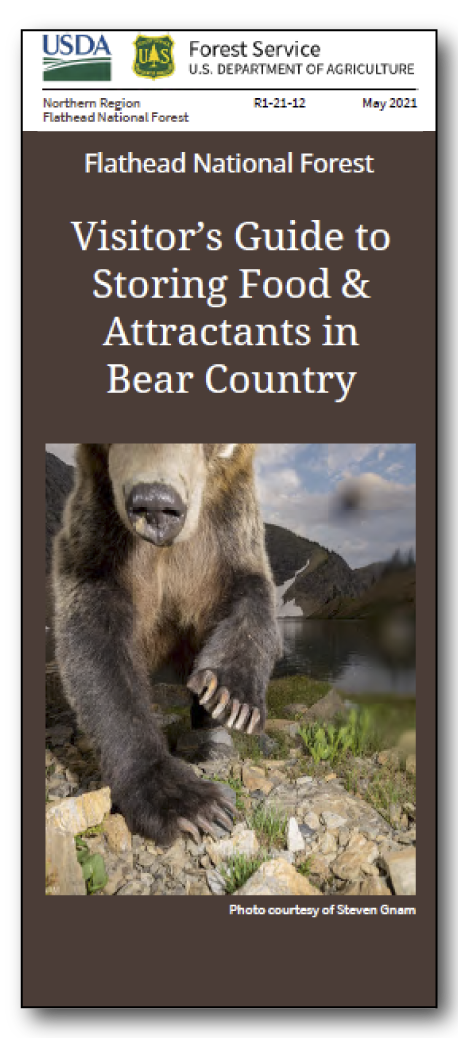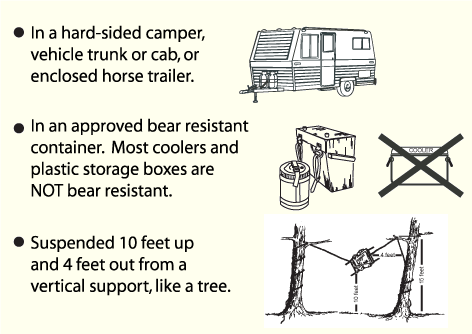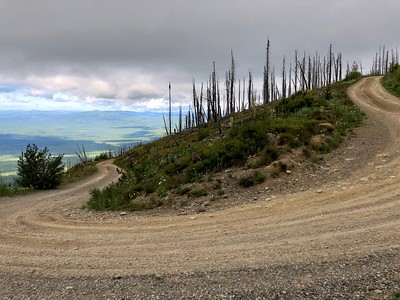Recreating Safely and Storing Your Food in Bear Country
On this page: Bear Encounters | Storing Attractants | Safety |
Hunting | Secure Habitat | Science & Management
Bears are Out Now!
 Bears start emerging from dens in March, and some don't den until late fall or early winter. Mountain bikers, trail runners, and other recreationists take note and read our brochure on fast-paced recreation in bear country! When you are on the trails, expect bears to be present.
Bears start emerging from dens in March, and some don't den until late fall or early winter. Mountain bikers, trail runners, and other recreationists take note and read our brochure on fast-paced recreation in bear country! When you are on the trails, expect bears to be present.
Moving quickly on a trail increases your chance of surprising a bear!
- Expect bears to be present
- Carry bear spray
- Make noise and slow down
- Avoid evening and early morning
- Avoid going alone
During a bear encounter:
- Stop. Do not run. Get off your bike, keep your bike between you and the bear.
- If the bear charges: stand your ground, use your bear spray.
- If the bear makes physical contact: protect your head and neck, play dead, use your bear spray.
- For more information visit the Interagency Grizzly Bear Committee and read our information below.
Many Montana national forests are home to the large and powerful grizzly bear. Where grizzly bears and humans occur together, conflicts may occasionally arise. The successful conservation and recovery of the grizzly bear involves habitat management and actions to minimize grizzly - human conflict potential.
Although aggression toward people and human injury is rare, incidents may occur during a surprise encounter, the protection of cubs, a defense of a food cache, or when bears have become accustomed to obtaining food associated with humans. When a bear becomes habituated to humans, displays aggression towards people or becomes conditioned to human food, the result is capture and relocation or removal from the population.
A fed bear is a dead bear! Two important bear habitat management actions involve proper storage of food, garbage and other attractants, and providing for secure habitat.
Food Storage Order for the Flathead National Forest Area:
 Special Orders designed to minimize grizzly bear/human conflicts are in place across the region. Storage of food, garbage and other attractants is restricted during occupancy and use on all national forests within the Northern Continental Divide Ecosystem and all of Flathead, Kootenai, and Lolo National Forests. These requirements are intended to help you avoid attracting grizzly bears into your camp or near to you while enjoying other non-camping forest activities. For your safety and for the recovery of the grizzly bear, your cooperation and compliance are needed.
Special Orders designed to minimize grizzly bear/human conflicts are in place across the region. Storage of food, garbage and other attractants is restricted during occupancy and use on all national forests within the Northern Continental Divide Ecosystem and all of Flathead, Kootenai, and Lolo National Forests. These requirements are intended to help you avoid attracting grizzly bears into your camp or near to you while enjoying other non-camping forest activities. For your safety and for the recovery of the grizzly bear, your cooperation and compliance are needed.
For more details on requirements see the NCDE Food Storage Special Order Food and other attractants are required to be stored in a bear resistant manner across the entire Flathead National Forest.
How to Store Attractants in Grizzly Country:
Within the special order boundaries, as shown on the maps, you are required to store ALL food, including canned food and beverages, garbage, pet food and livestock feed, and any other attractants (such as food leftovers or bacon grease and toiletries such as soap and toothpaste) in a bear resistant manner. None of these materials shall be buried, discarded, or burned in an open campfire. Think of those who may use the site after you leave.
When you are not at your camp or picnic site, store all food products and attractants in the following bear resistant manner:
- In a hard-sided camper, vehicle trunk, or cab, or enclosed horse trailer.
- In an approved bear resistant container. Most coolers and plastic storage boxes are NOT bear resistant.
- Suspended 10-feet up and 4-feet out from a vertical support, like a tree.
For more, read our brochure Visitor's Guide to Storing Food and Attractants in Bear Country
Safety Around Bears
 Your Flathead National Forest is home to both black and grizzly bears. Following these rules on food, garbage and attractant storage will help to keep you and future visitors safe. Visit the following links to learn more about how to be safe in bear country. Help prevent a situation where a bear is killed because it has become a nuisance or dangerous due to improper human actions.
Your Flathead National Forest is home to both black and grizzly bears. Following these rules on food, garbage and attractant storage will help to keep you and future visitors safe. Visit the following links to learn more about how to be safe in bear country. Help prevent a situation where a bear is killed because it has become a nuisance or dangerous due to improper human actions.
Bear Safety Information Resources
Brochures
- Visitor's Guide to Storing Food & Attractants in Bear Country (pdf)
- Biking and Running in Bear Country (pdf)
- Montana FWP Brochure: Hunting in Bear Country (pdf)
Interagency Grizzly Bear Committee
Glacier National Park and other Federal Agency Bear Information
State of Montana
- Montana Fish, Wildlife & Parks Bear Aware
- Grizzly Bear (Montana Field Guide)
- Black Bear (Montana Field Guide)
Hunting
There is a black bear hunting season in Montana. A bear identification program set up by the Montana Fish, Wildlife and Parks is intended to prevent mistaken identity killings of grizzly bears. Killing a grizzly bear in the lower 48 States is both a federal and state offense that can bring criminal and civil penalties of up to $50,000 and a year in jail.

Secure Habitat
Road access provides for important forest management and recreation but must be balanced with maintenance costs and environmental effects. Research has demonstrated that grizzly bear mortality is directly influenced by road access. Management of road access density involves using gates or berms to establish closures for motorized vehicles in order to create more secure habitat for grizzly bears and other wildlife.
For additional information view the Flathead National Forest brochure “Why are some roads closed?" We appreciate your cooperation in observing these restrictions. Check with the Forest or Ranger District office for more specific travel information.

Science and Management
All Federal Agencies have responsibility and are directed by the Endangered Species Act to utilize their authorities, in cooperation with State and local agencies, to promote the conservation of endangered and threatened species including the grizzly bear. The Interagency Grizzly Bear Committee was established to help ensure recovery of viable grizzly bear populations and their habitats in the lower 48 states through interagency coordination of policy, planning, management, and research. Current studies on genetics, population numbers, and population trends are being conducted within the Northern Continental Divide Ecosystem by the United States Geologic Service and the Montana Fish, Wildlife and Parks.
- U.S. Fish and Wildlife Service Grizzly Bear Recovery
- Interagency Grizzly Bear Committee Grizzly Bear Species Profile
United States Geologic Service: Monitoring Grizzly Bear Populations using DNA
- Population Dynamics and Habitat Relationships of Black Bears and Grizzly Bears in the Northern Rockies
- Monitoring Bear Populations with Non-Invasive Sampling



